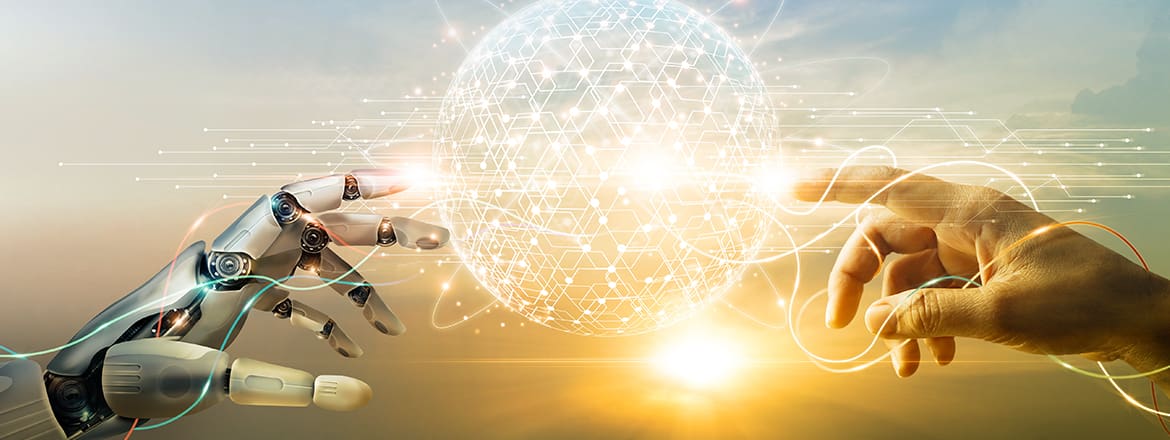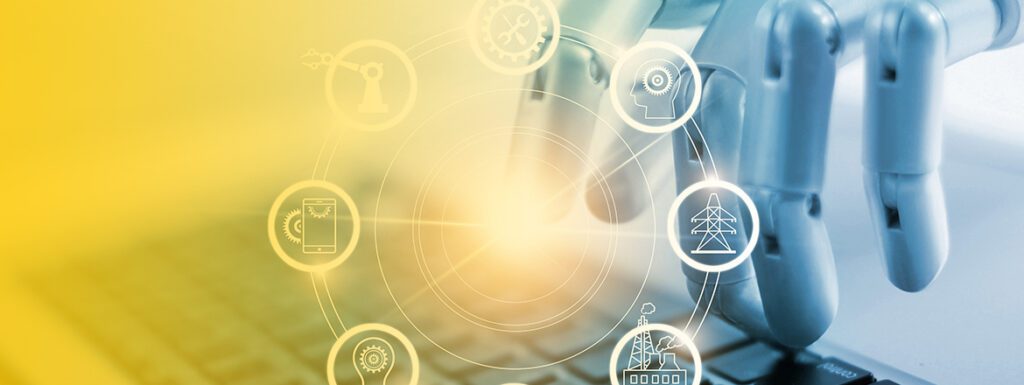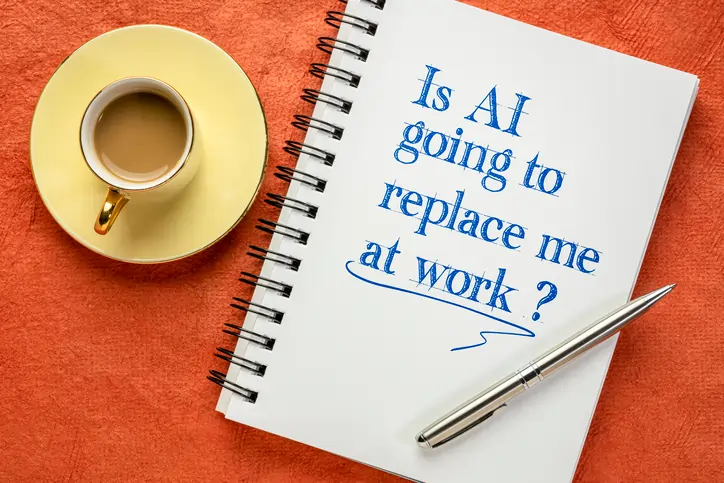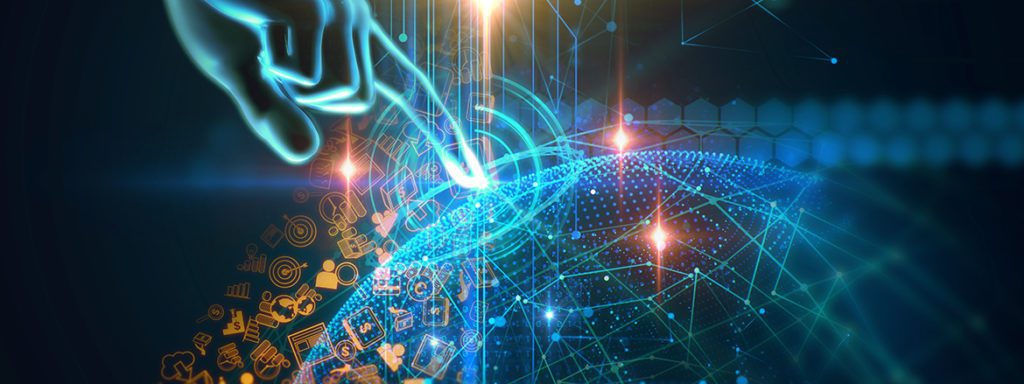The rapid advancement of technology has profoundly impacted almost every aspect of society, and artificial intelligence (AI) is at the forefront of this digital revolution. AI has transformed industries, business operations, and our day-to-day lives, and one area where its influence is increasingly apparent is workforce transformation. As new technologies emerge and businesses adapt to the digital age, understanding AI’s impact on workforce transformation becomes crucial for organizations to stay competitive and thrive in the future of work.
This article will discuss the impact of artificial intelligence on workforce transformation and how to leverage the power of these technologies for business success.
AI’s Increasing Influence on Our Society
AI’s influence spans beyond workforce transformation, permeating various aspects of society. From digital transformation to new technologies, AI has become an integral part of business operations, shaping the future of work. It is driving innovation, automation, and efficiency in healthcare, finance, manufacturing, and retail industries.
In digital transformation, AI is revolutionizing business operations by automating tasks, analyzing large amounts of data, and providing actionable insights to drive decision-making. With the ability to process and interpret massive datasets, AI enables businesses to make informed decisions, optimize processes, and gain a competitive edge in the market.
Understanding AI’s Influence on Workforce Transformation
Workforce transformation encompasses strategic planning, reimagining business models, and fostering an environment that embraces change. With its ability to process vast amounts of data, analyze patterns, and automate tasks, AI plays a pivotal role in enabling companies to adapt to the evolving business landscape.
Workforce planning, previously a time-consuming and complex process, benefits significantly from AI technologies. With AI-driven analytics, organizations can strategically align their workforce with business goals, identify skills gaps, and develop targeted strategies for attracting, retaining, and developing talent. Additionally, AI helps companies stay agile in changing market dynamics, allowing them to optimize workforce operations and deploy resources effectively.
The integration of AI also ushers in new employees with different skill sets and mindsets. As companies embrace automation and AI technologies, new roles and job opportunities emerge, requiring employees to possess future skills such as data analytics, machine learning, and digital literacy. AI-driven workforce transformation ensures companies have the right people with the right skills at the right time, positioning them for success now and in the future.
The Concept of AI in Workforce Transformation
Artificial intelligence has become a buzzword in recent years, revolutionizing how companies approach workforce transformation. The concept of AI in workforce transformation goes beyond automation and cost savings. It encompasses employee engagement, strategic goals, and organizational transformation.
AI empowers companies to engage their workforce in new and innovative ways. By automating mundane and repetitive tasks, employees can focus on more strategic and value-added work, boosting productivity and job satisfaction. Moreover, AI technologies enable personalized experiences tailored to individual employee needs, fostering a culture of continuous learning and development.
AI’s capabilities redefine strategic goals and business operations. With the ability to analyze vast amounts of data and generate insights, companies can make data-driven decisions that align with their strategic objectives. AI-driven workforce transformation enables companies to adapt and thrive in an increasingly competitive business landscape, maximizing productivity and driving growth.
The Role of AI in Shaping the Future Work Environment
AI’s role in shaping the future work environment cannot be overstated. As new technologies emerge, companies must adapt their organizational goals, business strategy, and workforce planning to stay ahead.
AI significantly shapes the future work environment by creating new roles. While AI automates specific tasks, it also allows employees to take on new, more strategic roles that require human judgment, creativity, and emotional intelligence. These roles often involve leveraging AI tools and analytics to make informed decisions, maximize efficiencies, and drive innovation.
Organizational goals are redefined with the integration of AI. Companies increasingly focus on harnessing AI technologies to optimize business operations, improve customer experiences, and drive growth. By leveraging AI tools, companies can gain valuable insights from data analytics, enabling them to make strategic decisions that align with their goals and drive future success.
Importance of AI-Driven Workforce Transformation
AI-driven workforce transformation is paramount for companies looking to stay competitive in the digital age. It enables organizations to align their workforce with strategic goals, increase operational efficiency, and drive innovation.
1. Precision and Efficiency: One of the primary advantages of integrating AI into workforce strategies is the unparalleled precision and efficiency it brings to various processes. AI algorithms process vast amounts of data, identify patterns, and make data-driven decisions. This reduces the margin of error and frees up human resources to focus on tasks that require creativity, critical thinking, and emotional intelligence. By automating routine and mundane tasks, employees can channel their efforts into activities that add more value to the organization.
2. Enhanced Productivity: AI-driven workforce transformations significantly contribute to enhanced productivity. With the automation of repetitive tasks, employees can streamline their workflows and accomplish more in less time. Intelligent and robotic process automation (RPA) can handle routine tasks, allowing employees to concentrate on complex, strategic, and client-facing activities. This shift towards higher-value tasks boosts individual productivity and contributes to the organization’s efficiency and effectiveness.
3. Continuous Learning and Development: AI empowers organizations to establish a continuous learning and development culture. AI-driven systems can analyze employee performance data to identify skill gaps and recommend personalized training programs. This ensures that the workforce remains adaptable and up to date with industry trends and technological advancements. Continuous learning benefits employees in their career growth and equips organizations with a skilled and agile workforce ready to tackle emerging challenges.
4. Strategic Decision-Making: Incorporating AI into workforce strategies enables organizations to make more informed and strategic decisions. Advanced analytics and predictive modeling powered by AI provide valuable insights into employee performance, engagement, and overall organizational dynamics. This data-driven approach facilitates proactive decision-making, allowing businesses to anticipate challenges, optimize resource allocation, and stay ahead of the competition.
5. Long-Term Benefits for Organizations and Employees: Incorporating AI into workforce strategies doesn’t just offer short-term gains; it sets the stage for long-term benefits. Organizations that embrace AI-driven transformations position themselves as industry leaders, attracting top talent seeking innovative and tech-forward workplaces. For employees, exposure to AI technologies enhances their skill set, making them more marketable in a technology-driven job market. Additionally, by automating repetitive tasks, organizations create a more satisfying work environment, fostering employee engagement and retention.
How AI Boosts Efficiency in the Workforce
AI’s impact on workforce transformation extends beyond strategic goals and organizational objectives. It is pivotal in boosting efficiency, driving cost savings, and streamlining business operations.
By automating repetitive tasks, AI frees up employees’ time, allowing them to focus on high-value work that requires human judgment and creativity. This automation boosts efficiency and reduces human error, improving overall business operations. Additionally, AI technologies can analyze large datasets, generate insights, and make data-driven recommendations, enabling employees to make informed decisions quickly.
The cost savings associated with AI are significant. By automating routine processes, companies can reduce labor costs, increase productivity, and reallocate resources to higher-value activities. With improved efficiency and reduced manual work, companies can save costs while driving business growth and innovation.
Benefits of AI in Workforce Skill Enhancement
AI offers significant benefits in workforce skill enhancement, enabling companies to upskill and reskill employees for future roles and technologies. As highlighted by Accenture, AI plays a crucial role in fostering business growth by freeing up 60-70% of employees’ time, enabling them to focus on tasks of higher value.
Upskilling and developing new employee skills are crucial in workforce transformation. Companies can use AI-powered tools to identify skills gaps, customize training programs, and provide employees with personalized learning experiences. Through upskilling, employees can stay relevant, contribute to organizational goals, and embrace new technologies confidently.
Reskilling, the process of training employees in new skills, is essential as business operations evolve. AI enables companies to provide employees with access to new tools, technologies, and training resources, empowering them to learn and adapt to changing business needs. This reskilling enhances employee engagement and equips companies with the skills necessary to drive innovation and embrace new opportunities.
Here are some of the other benefits of leveraging artificial intelligence in workforce skill enhancement:
1. Personalized Learning Paths: AI analyzes vast datasets and derives actionable insights. In the context of workforce skill enhancement, this capability allows AI to create personalized learning paths for individuals. By assessing the strengths and weaknesses of each employee, AI-driven systems can recommend tailored training programs, ensuring that the learning experience is targeted and relevant to individual needs. This personalized approach enhances the efficiency of skill development initiatives.
2. Adaptive Learning Platforms: Traditional learning methods often need help to keep pace with individuals’ diverse needs and learning speeds. AI, however, introduces adaptive learning platforms that dynamically adjust to each learner’s progress. These platforms use real-time data to modify content, difficulty levels, and pacing, ensuring employees receive a customized learning experience. This adaptability accelerates skill development and maximizes engagement and knowledge retention.
3. Identifying and Addressing Skill Gaps: One of the significant challenges organizations face is identifying and addressing skill gaps within their workforce. AI comes to the rescue by analyzing performance data, project outcomes, and industry trends to pinpoint areas where employees may lack proficiency. This data-driven approach enables organizations to address skill gaps proactively, align training programs with business needs, and ensure that employees possess the skills necessary for the future of work.
4. Real-time Feedback and Evaluation: AI facilitates real-time feedback and evaluation mechanisms, providing employees instant insights into their progress. Whether it’s through interactive simulations, virtual reality scenarios, or AI-assisted assessments, employees can receive immediate feedback on their performance. This accelerates the learning process and fosters a culture of continuous improvement, where employees are motivated to refine their skills based on real-time guidance.
5. Enhancing Soft Skills: While technical skills are vital, soft skills such as communication, collaboration, and problem-solving are equally important. AI-driven simulations and virtual scenarios provide employees with immersive experiences that help develop and refine these essential soft skills. This holistic approach to skill enhancement ensures that employees are well-rounded and equipped to navigate the complexities of the modern workplace.
Strategies for Empowering Employees
To empower employees in an AI-driven workforce, organizations must implement strategies that prioritize upskilling and reskilling initiatives, foster a culture of continuous learning, leverage AI for personalized learning experiences, and encourage collaboration between humans and AI.
Upskilling and reskilling initiatives are critical for workforce transformation, ensuring employees possess future skills and remain adaptable in an ever-changing business landscape. To enable these initiatives, organizations can:
- Identify skills gaps through AI-driven analytics.
- Develop targeted training programs and mentorship opportunities.
- Provide access to online courses and resources for continuous learning.
- Encourage employees to embrace new technologies and digital transformation.
Additionally, new workforce employees can benefit from upskilling programs, equipping them with the necessary skills to contribute meaningfully to the organization right from the start.
Upskilling and Reskilling Initiatives
In the current situation, upskilling and reskilling initiatives are crucial in shaping the company’s workforce. According to a survey by McKinsey, 38% of organizations using AI anticipate the need to reskill over 20% of their workforce. With artificial intelligence impacting businesses’ operations, new employees must acquire the right skills at the right time. In recent years, HR and organizations have recognized the importance of empowering individuals to enhance their skills, making upskilling and reskilling initiatives integral to workforce development. Elev8 emphasizes the significance of upskilling and reskilling initiatives in preparing organizations’ workforce for the future.
Creating a Culture of Continuous Learning
A key strategy for empowering employees in an AI-driven workforce transformation is creating a culture of continuous learning. Organizations must prioritize employee engagement, align goals, and embrace new technologies to foster ongoing growth and development.
To create a culture of continuous learning, organizations can:
- Encourage employees to embrace new technologies and digital transformation, creating an environment where experimentation and learning are encouraged.
- Implement learning management systems that provide employees access to online courses, digital resources, and collaboration tools.
- Align organizational goals with employee learning and development, ensuring that skills acquisition is directly linked to strategic objectives.
- Support employees in acquiring new skills through mentorship programs, coaching, and ongoing professional development opportunities.
- By fostering a culture of continuous learning, organizations can drive employee engagement, adapt to digital transformation, and ensure their workforce remains agile and future ready.
Leveraging AI for Personalized Learning Experiences
Leveraging AI to deliver personalized learning experiences is another strategy organizations can employ to empower employees in workforce transformation. AI technologies can analyze vast amounts of data and provide individualized recommendations, tailoring learning experiences to meet employees’ needs and goals.
Organizations can leverage AI for personalized learning experiences by:
- Utilizing AI-powered tools that adapt to individual employee progress and provide real-time feedback.
- Customizing learning paths based on employees’ existing skills, career aspirations, and learning preferences.
- Implementing intelligent chatbots or virtual assistants that can answer employee questions and provide support during the learning process.
- Using AI to recommend relevant resources, courses, and training materials based on employees’ skills gaps and interests.
- By incorporating AI into the learning process, organizations can enhance employee engagement, improve learning outcomes, and ensure employees have the skills necessary to thrive in an AI-driven workforce.
Fostering Collaboration between Humans and AI
Collaboration between humans and AI is essential in workforce transformation, as AI technologies augment human capabilities and redefine roles. To foster this collaboration, organizations must create an environment that values employee engagement and leverages the strengths of both humans and AI.
Organizations can foster collaboration between humans and AI by:
- Encouraging employees to embrace new roles and responsibilities in an AI-driven work environment.
- Establishing clear communication channels between employees and AI tools, ensuring transparency and a shared understanding of goals and responsibilities.
- Promoting collaboration between employees and AI technologies, enabling employees to work alongside AI as partners, leveraging each other’s strengths.
- Providing upskilling and reskilling opportunities that equip employees with the skills necessary to work effectively with AI technologies.
- By fostering collaboration, organizations can harness the power of AI while empowering employees, creating a workforce that is adaptable, innovative, and capable of driving business success.
Challenges in Implementing AI in Workforce Transformation
Implementing AI in workforce transformation comes with its own set of challenges, ranging from resistance to change to addressing the impact on the current workforce. Organizations must navigate these challenges to harness the potential of AI technologies fully.
One of the challenges is managing the transition for the current workforce. AI-driven workforce transformation may create employee concerns about job security and the changing nature of their roles. Organizations must communicate effectively, provide training and support, and demonstrate how AI technologies can enhance employee productivity and job satisfaction.
Another challenge lies in developing effective business strategies that incorporate AI technologies. From workforce planning to talent acquisition, organizations must align their business strategy with AI integration. This requires careful consideration of metrics, benchmarks, and key performance indicators that evaluate the impact of AI on business operations and workforce efficiency.
Lastly, businesses need to address ethical implications associated with AI integration, such as data privacy, transparency, and the potential bias of AI algorithms.
Future of AI in Workforce Transformation
Looking ahead, AI will continue to shape the future of workforce transformation. As AI technologies evolve, workforce planning, strategic goals, and HR practices will adapt to leverage the full potential of AI.
The future of work will be characterized by a harmonious collaboration between humans and AI, with new roles emerging that blend human skills, creativity, and emotional intelligence with AI technologies. Workforce planning will be driven by analytics, enabling companies to identify future skills, develop talent pipelines, and allocate resources effectively.
AI technologies will help organizations achieve their strategic goals, whether streamlining operations, enhancing customer experiences, or driving innovation. From HR practices to learning and development initiatives, AI will profoundly impact how companies attract, retain, and develop talent, ultimately shaping the future of workforce transformation.
As the workforce evolves, AI will play a critical role in reshaping business operations, redefining organizational goals, and ensuring companies remain agile in digital transformation. By embracing AI technologies in workforce transformation, companies can future-proof their operations, achieve strategic goals, and stay at the forefront of the ever-changing business landscape.
Has AI Transformed Your Workforce Yet?
Assessing the impact of AI on your workforce is crucial in understanding the current situation of workforce transformation within your organization. AI technologies can transform businesses’ operations, optimize workforce planning, and enhance employee engagement. By evaluating the current state of your company’s workforce and its interaction with AI, you can identify areas for improvement, untapped opportunities, and potential challenges.
Leveraging AI tools to optimize workforce planning, employee engagement, and skill enhancement can drive significant benefits, such as increased productivity, cost savings, and improved business outcomes. As AI technologies continue to evolve, the time to evaluate, embrace, and leverage AI in workforce transformation is now. By harnessing the power of AI, companies can prepare their workforce for the future, stay ahead of the competition, and confidently navigate the complex digital landscape. If you want to explore how AI can transform your workforce, contact us to learn more.




